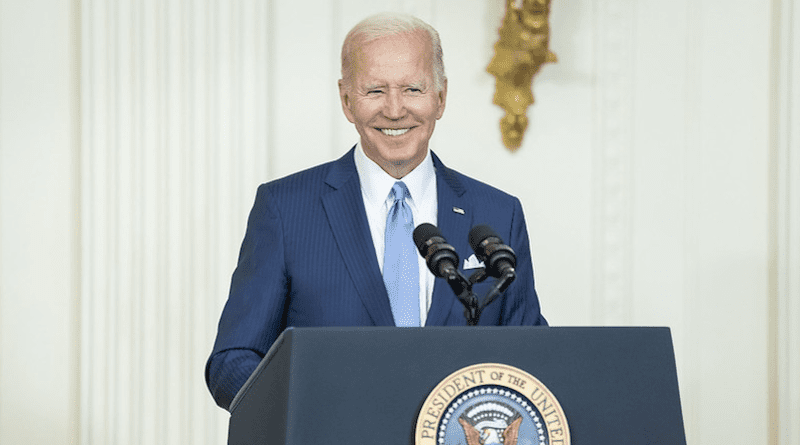Why Democrats’ Midterms Hopes Are Improving – OpEd
By Arab News
By Kerry Boyd Anderson*
The US is now two months away from its midterm elections. Previously, many political analysts and campaigners had assumed that a “red wave” would hand Republicans control of both chambers of Congress. However, recent events and new polling suggests that the elections might be more competitive than expected.
US midterm elections are held near the middle point of a president’s term. Since the Second World War, the president’s party has lost seats in Congress in the vast majority of midterm elections. Simply based on the historical record, Republicans could expect to do well in the elections on Nov. 8. Democrats currently control the Senate and House by very slim margins, so Republicans only need to gain a few seats to control Congress.
For much of this year, the political environment looked very promising for Republicans, prompting talk of a red wave delivering huge gains. Americans often blame the president and his party for economic woes, and polls showed that Americans were worried about the economy. Inflation has a particularly acute sting, so the highest levels of inflation in decades seemed ominous for Democrats. President Joe Biden’s approval ratings this year have been very low, down to 37.5 percent in July, according to FiveThirtyEight.
However, recent indications suggest that a red wave is less likely and that Republicans might struggle for control of Congress. This summer, Republicans underperformed expectations in five special elections. Most notably, a Democrat won a previously Republican-held House seat in Alaska; while that election had several unique characteristics that limit its applicability to the rest of the country, a Democratic win in a typically Republican state must at least raise some doubts about a coming red wave.
Polls and expert forecasts also suggest an improving environment for Democrats. The Cook Political Report recently reported that, while Democrats remain behind Republicans, their electoral chances are improving. The widely used FiveThirtyEight models also show shifts in favor of Democrats. Currently, FiveThirtyEight gives the Democrats a 68 in 100 chance of maintaining a Senate majority — a very significant improvement over the summer. It gives the Republicans a 75 in 100 chance of winning a majority in the House of Representatives, which suggests a small improvement for Democrats since June, though Republicans still lead.
Meanwhile, FiveThirtyEight’s polling average for the generic ballot, which asks voters which party they would vote for, shows Democrats slightly ahead of Republicans for the first time in 2022. The generic ballot is not predictive, but it is a useful indicator for shifting trends in public opinion.
Multiple factors are driving the improvements in Democrats’ prospects. Inflation appears to be slowing, while the job market remains strong, potentially easing economic concerns. Biden’s approval ratings are improving, now at about 43 percent. He can claim several recent legislative victories. Crucially for the midterms, polls show that his ratings with independent voters have improved.
In midterm elections, parties often try to win over moderate voters who might be disappointed in the president. However, the Republican Party has doubled down on more extreme rhetoric and candidates. In particular, former President Donald Trump endorsed several deeply divisive candidates who lack political experience — some of whom are now underperforming expectations in their races. Many Republican primary elections earlier this year produced candidates who openly question the validity of Biden’s election, support Trump and embrace far-right ideas and language. While these candidates are likely to do well in deeply Republican districts and states, they are more likely to struggle in competitive elections.
More broadly, Americans appear to be reacting to a sense of extremism within the Republican Party. Democrats’ electoral fortunes improved after the Supreme Court overturned decades-old rights to abortion, and multiple Republican-led states have passed laws banning or restricting abortion in ways that go far beyond the average American’s comfort level. While some Democrats perceive a reaction specifically in response to the abortion issue, it is more likely that the abortion issue highlighted the Republican Party’s broader embrace of far-right views. For example, the Supreme Court not only overturned previous decisions on abortion, but also Justice Clarence Thomas suggested that the court should review other rights, such as the right to contraception.
Meanwhile, the congressional hearings about the Jan. 6, 2021, invasion of the US Capitol have kept a spotlight on the attack, Trump’s election denials and Republican leaders’ discomfort in addressing it. Meanwhile, some Republican state legislatures have embraced controversial school policies, among other divisive issues. All of this and more might make moderate Americans less likely to vote for Republican candidates.
In looking ahead to November, it is wise to be cautious. Put simply, the current US political environment is weird and historical precedents provide limited guidance. Much can change in two months. Potentially disruptive events could include more direct NATO involvement in the war in Ukraine, increased tensions with China, a new surge in COVID-19 infections, political assassinations and much more. It is difficult to predict how such events would shape the elections. Polls could be wrong.
Furthermore, Trump presents an X-factor. For example, the recent news about the FBI raid at Mar-a-Lago and the revelations that Trump had taken highly classified documents and stored them insecurely have the potential to further alienate moderates, while galvanizing both Democrats and Republicans. With Trump in the mix, accurate forecasting is difficult at best.
For now, Republicans have the advantage, but Democrats look increasingly likely to block a red wave.
- Kerry Boyd Anderson is a writer and political risk consultant with more than 18 years of experience as a professional analyst of international security issues and Middle East political and business risk. Her previous positions include deputy director for advisory with Oxford Analytica. Twitter: @KBAresearch

